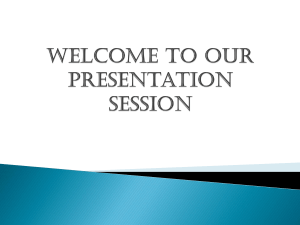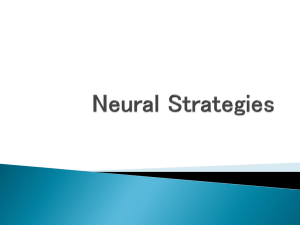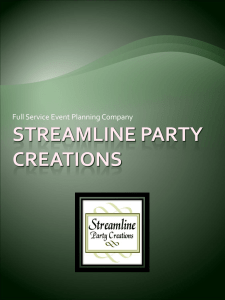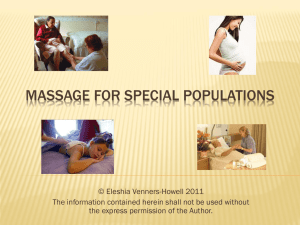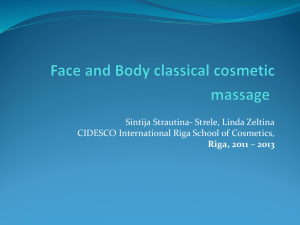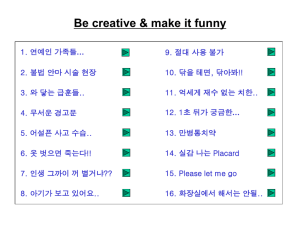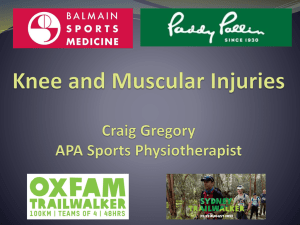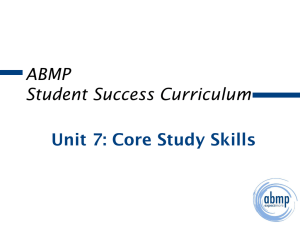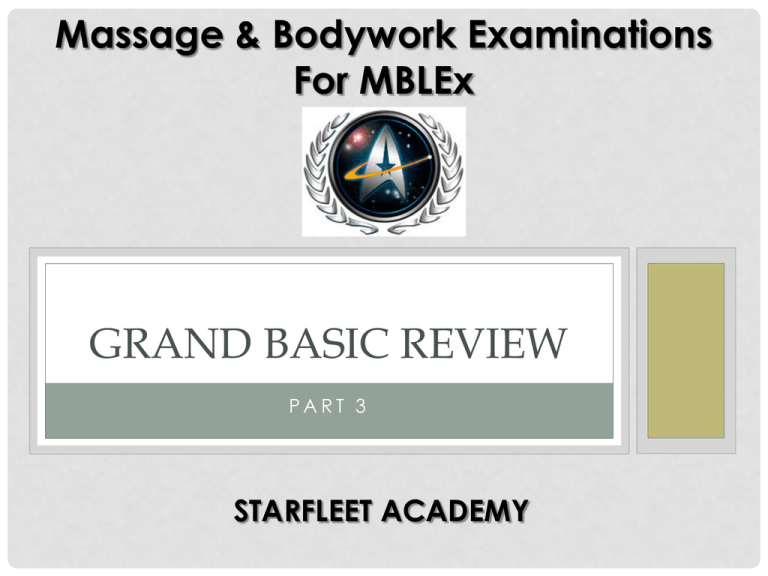
Massage & Bodywork Examinations
For MBLEx
GRAND BASIC REVIEW
PART 3
STARFLEET ACADEMY
GENERAL REVIEW
1.
Another term for the inner ear is the ______.
a.
Reticulum
b.
Arachnoid
c.
Labyrinth
d.
Copia
GENERAL REVIEW
2.
The main muscle responsible for any movement is the
______.
a.
Synergist
b.
Antagonist
c.
Protagonist
d.
Agonist
GENERAL REVIEW
3.
it.
______ allows us to move without thinking about
a.
Proprioception
b.
Stimulus
c.
Flexion
d.
Extension
GENERAL REVIEW
4.
Ergonomics is concerned with ______ factors pertaining to
the environment.
a.
Mineral
b.
Animal
c.
Human
d.
Vegetable
GENERAL REVIEW
5.
The three laws of motion were identified by
______.
a.
Sir Isaac Newton
b.
Sir Stephen Newton
c.
Dr. Stephen Hawking
d.
Galileo
GENERAL REVIEW
6.
The factor that affects how or how much a bone is going to
move is the ______.
a.
Position of the joint
b.
Resistance encountered
c.
Effort required
d.
All of the above
GENERAL REVIEW
7.
The rarest lever in the body is the ______.
a.
First-class lever
b.
Second-class lever
c.
Third-class lever
d.
Fourth-class lever
GENERAL REVIEW
8.
Improper biomechanics can cause ______.
a.
Injury
b.
Poor posture
c.
Carpal tunnel syndrome
d.
All of the above
GENERAL REVIEW
9.
The sensory perception of muscle movement is ______.
a.
Myasthenia
b.
Kinesiology
c.
Kinesthesia
d.
Myasthology
GENERAL REVIEW
10.
An example of a second-class lever in the body
is the ______.
a.
Hip joint
b.
Elbow joint
c.
Atlas
d.
Ball of the foot
GENERAL REVIEW
11.
Pain, stiffness, and numbness or tingling on the back
of the leg might indicate ______.
a.
An impingement of the trigeminal nerve
b.
Sciatica
c.
Coryza
d.
An inflamed metatarsal
GENERAL REVIEW
12.
A dancer holding a pose standing on one leg with
arms abducted 90 degrees is an example of ______.
a.
Ballistic balance
b.
Static balance
c.
Dynamic balance
d.
Neutral position
GENERAL REVIEW
13.
The elbow joint is a ______ lever.
a.
First class
b.
Second class
c.
Third class
d.
Fourth class
GENERAL REVIEW
14.
Proprioception is self-regulated by the ______
system.
a.
Psychosomatic
b.
Somatosensory
c.
Nervous
d.
Muscular
GENERAL REVIEW
15.
The sensory nerve ending that responds to a stimulus is the
______.
a.
Receptor
b.
Affector
c.
Effector
d.
Deflector
GENERAL REVIEW
1.
A client comes in and reports that her lower back
has been hurting ever since she mowed her lawn yesterday.
In which section of the SOAP notes is this information
recorded?
a.
S
b.
O
c.
A
d.
P
GENERAL REVIEW
2.
To assist in making a postural assessment, you could
use ______.
a.
A plumb line
b.
A grid
c.
Two pieces of tape on the wall
d.
All of the above
GENERAL REVIEW
3.
SOAP is the acronym for ______.
a.
Structure, Objective, Assessment, Protocol
b.
Subjective, Objective, Assessment, Practice
c.
Subjective, Observation, Action, Plan
d.
Subjective, Objective, Assessment, Plan
GENERAL REVIEW
4.
Informed consent should be obtained from each client. You
should obtain it _____.
a.
Before doing any work on the client
b.
Before the client leaves the office
c.
After the client has completed one session
d.
While the client is on the table
GENERAL REVIEW
5.
Your client is experiencing pain in the arm, wrist, and hand. You
are pretty sure he has carpal tunnel syndrome. You should take the
following action:
a.
Share your diagnosis with the client
b.
Apply a heating pad for a short time followed by
cryotherapy
c.
Tell him to take a couple of aspirin for the pain, and give
him some exercises to do at home
d.
Suggest that he see his doctor for a diagnosis
GENERAL REVIEW
6.
Touching and feeling the muscles for signs of tautness or trauma
is referred to as ______.
a.
Effleurage
b.
Palpation
c.
The Knapp technique
d.
Nerve stroking
GENERAL REVIEW
7.
Your client reports that she is suffering from cat scratch fever.
She really doesn't have much information on it. You should ______.
a.
Call the doctor before doing the massage
b.
Just go with the limited information she gave you
c.
Call your aunt who has seven cats for advice
d.
Send her home and tell her to come back when she is
well
GENERAL REVIEW
8.
Because you were running late, you hurriedly put a first-time client
on the table without performing any physical assessments other than quickly
looking him over while he filled out the intake form. As you start to work on
him, you notice that his shoes on the floor are very unevenly worn on the
outside of the heel. This is a sign that ______.
a.
The feet are inverted
b.
The feet are everted
c.
His latissimus dorsi is shortened
d.
He has calcium deposits on his calcaneus
GENERAL REVIEW
9.
When a client experiences an emotional release on the
table, you should ______.
a.
Tell her what happened when you were confronted
with the same situation
b.
Act as if nothing unusual is happening
c.
Be present with her and act the part of a
concerned listener
d.
Stop the massage; you can't deal with this
GENERAL REVIEW
10.
Subjective information is obtained by ______.
a.
Assessing the way the client walks
b.
Palpation
c.
Standing the client on the plumb line
d.
Listening to the client
GENERAL REVIEW
11.
A care plan is ______.
a.
A list of contraindications
b.
A list of mutually agreeable goals and course of
treatment decided upon between client and therapist
c.
An assessment
d.
SOAP notes
GENERAL REVIEW
12.
A client reported waking up to find her pillow on the
floor and being unable to turn her head. Her primary
problem is ______.
a.
Gate
b.
Posture
c.
Range of motion
d.
Elasticity
GENERAL REVIEW
13.
Your recommendations of soaking in an Epson
salt bath and increasing water intake in order to hydrate
the muscles should be recorded on section ______ of the
SOAP notes.
a.
S
b.
O
c.
A
d.
P
GENERAL REVIEW
14.
Informed consent can be ______ at any time.
a.
Withdrawn
b.
Ignored
c.
Modified
d.
Both a and c
GENERAL REVIEW
15.
Which question is inappropriate for any intake interview?
a.
Has your condition limited your activity?
b.
When was your last period?
c.
Do you have insurance?
d.
Where did you receive your last massage?
GENERAL REVIEW
1.
A new client comes in and states in the intake interview that he is
HIV positive. Your response is to ______.
a.
Interview him a little more thoroughly to find out what, if
any, complications he has and proceed with the massage
in the normal manner, observing all universal precautions
b.
Tell him to go to the doctor and get a permission slip for the
massage
c.
Refuse to work on him; you don't want to get HIV
d.
Ask him how he got the condition
GENERAL REVIEW
2.
If you have a bad cold, you should ______.
a.
Go ahead and work; it won't kill you
b.
Call your clients and reschedule them
c.
Blow your nose repeatedly during the massage
d.
Say nothing about it, and maybe your clients won't
notice how sick you are
GENERAL REVIEW
3.
A client coughs into her hands several times during the
massage session. As a measure of precaution, what should you do
before the next client arrives?
a.
Change the linens
b.
Ask the client to get up and wash her hands
c.
Disinfect everything she has touched with a
germicide
d.
Offer her a pair of your disposable gloves
GENERAL REVIEW
4.
Universal precautions should be observed ______.
a.
With all clients who have any symptoms
b.
With any client who is HIV positive
c.
With any client
d.
With any client who has recently been sick
GENERAL REVIEW
5.
A client comes in who has an ugly red rash. She said she hasn't
been to the doctor because the rash just broke out yesterday and it
doesn't itch, so she doesn't think it's serious. The best course of action is
______.
a.
Put on gloves and give her the massage
b.
Offer her some lavender oil for the rash
c.
Don't worry about it at all, because she isn't concerned
about it and it doesn't itch
d.
Politely refuse to perform the massage until she sees the
doctor
GENERAL REVIEW
6.
If you sneeze while you are giving someone a massage, you
should ______.
a.
Say "excuse me"
b.
Don't acknowledge it at all; you think the client is
asleep anyway
c.
Excuse yourself to go wash your hands
d.
Wipe your hand on your shirt
GENERAL REVIEW
7.
You should wash your hands ______.
a.
Before and after you have your lunch break
b.
After handling the laundry at the office
c.
Before and after each client
d.
All of the above
GENERAL REVIEW
8.
It is wise for massage therapists to be trained in CPR and First Aid
because _____.
a.
The National Board requires it
b.
They might have to be a first responder
c.
They can't get licensed if they don't
d.
It makes them appear more credible and professional
GENERAL REVIEW
9.
The purpose of proper draping is ______.
a.
To respect the modesty of the client
b.
To protect the integrity of the therapist
c.
To keep the client warm
d.
All of the above
GENERAL REVIEW
10.
If a client tells you that he is not cold or modest and he
doesn't need the drape, you should ______.
a.
Take it off of him
b.
Explain that draping is a law, as well as a safety
precaution, and you are obligated to abide by that
c.
Act as if you didn't hear him and carry on with the
massage
d.
None of the above
GENERAL REVIEW
11.
You would try restoring normal breathing to a client who has a
heart attack by performing ______.
a.
CRP
b.
CPR
c.
PCR
d.
CVA
GENERAL REVIEW
12.
A client who has a chronic condition may be
massaged as long as he or she is not in a(n) ______ phase.
a.
Subacute
b.
Waning
c.
Acute
d.
Dormant
GENERAL REVIEW
13.
Maintaining a clean and sanitary office is
important ______.
a.
In order to impress your customers
b.
For the safety and health of your clients
c.
To keep the health inspector satisfied
d.
To comply with AMTA guidelines
GENERAL REVIEW
14.
As health care practitioners, our first
responsibility is ______.
a.
To keep a clean facility
b.
To interview the client
c.
To provide clean linens and drapes
d.
To do no harm
GENERAL REVIEW
15.
A sneeze or cough can transmit diseases such as colds, the
flu, or tuberculosis through ______.
a.
Sexual contact
b.
Droplet transmission
c.
Casual contact
d.
Blood transfusion
GENERAL REVIEW
1.
Your first client of the day tells you she has been taking her own
temperature every morning as a means of tracking her ovulation. She tells
you she has a low-grade fever this morning, but she isn't worried because
she feels fine. You should ______.
a.
Go ahead with the deep tissue massage she is scheduled
for
b.
Give her a massage, but make it Swedish so it isn't that
deep
c.
Reschedule the appointment
d.
Call her doctor
GENERAL REVIEW
2.
A client with extremely high blood pressure disagrees with
her doctor about whether massage is contraindicated and informs
you she is going against his advice because she wants the
massage. You are going to ______.
a.
Send her home without the massage
b.
Call the doctor before making a decision
c.
Put her on the table and use gentle holding
techniques and/or energy work
d.
Have her sign a release for relieving you of any
responsibility, and give her a massage
GENERAL REVIEW
3.
The popliteal triangle, an endangerment site, is located
______.
a.
In the hollow of the throat
b.
Superior to the pubic symphysis
c.
Inferior to the mandible
d.
Behind the knee
GENERAL REVIEW
4.
Thrombosis is another term for a ______.
a.
Blood clot
b.
Thyroid disorder
c.
Sore throat
d.
Lung inflammation
GENERAL REVIEW
5.
A client who has had recent radiation therapy may be
contraindicated for deep tissue massage because of the effect of
radiation on the ______.
a.
Digestive system
b.
Skeletal system
c.
Integumentary system
d.
Muscular system
GENERAL REVIEW
6.
Endangerment sites are places on the body that should be
avoided because ______.
a.
The veins are too close to the heart
b.
Organs in the area are subject to inflammation if
massage is performed
c.
Veins, arteries, and/or nerves are superficial
d.
A benign tumor is present
GENERAL REVIEW
7.
A regular client confides to you that she recently has had a
mental illness diagnosed and has been experiencing intermittent
psychotic episodes. Your best course of action is to ______.
a.
Refuse to treat her anymore
b.
Be prepared to subdue her in case she gets violent
c.
Call her doctor (with her permission) to be able to
make a more informed decision
d.
Call her doctor (without her permission) to be able to
make a more informed decision
GENERAL REVIEW
8.
You should never massage someone who is under the influence of
drugs or alcohol because the client ______.
a.
May not be in control of him- or herself
b.
May say or do something inappropriate
c.
May accuse you of saying or doing something
inappropriate
d.
All of the above
GENERAL REVIEW
9.
One example of an endangerment site is ______.
a.
Just below the medial malleolus
b.
The axillary area
c.
The maxilla
d.
The occipital ridge
GENERAL REVIEW
10.
A new client refuses to fill out the intake form and tells you that she
doesn't believe in doctors or modern medicine. She tells you she hasn't been
to the doctor for more than 20 years and claims to have no medical
problems. Your best course of action is to ______.
a.
Decline to have her as a client; she may have a condition
that is a definite contraindication that has gone
undiagnosed because she does not see a doctor
b.
Refer her to another therapist who is not a stickler for
following the rules
c.
Conduct a thorough interview, filling out the form as you go
along, and check her blood pressure; if it is normal, go
ahead with the massage
d.
Proceed with the massage without any further probing
GENERAL REVIEW
11.
A sac-like protrusion is a(n) ______.
a.
Bolus
b.
CVA
c.
Arteriole
d.
Aneurysm
GENERAL REVIEW
12.
Hemophilia is caused by ______.
a.
An iron deficiency in the blood
b.
An overabundance of iron in the blood
c.
A lack of clotting factors in the blood
d.
The inability to metabolize carbon dioxide
GENERAL REVIEW
13.
_______ is an inflammation of the connective
tissue covering the bones, except at the joints.
a.
Periostitis
b.
Gingivitis
c.
Myositis
d.
Tenosynovitis
GENERAL REVIEW
14.
A systemic disease is one that affects _______.
a.
A certain body system
b.
A specific type of cell
c.
The whole body
d.
A certain organ
GENERAL REVIEW
15.
Dislodging a thrombosis could result in _______.
a.
Pulmonary embolism
b.
Graves disease
c.
An asthma attack
d.
Arteriosclerosis
GENERAL REVIEW
1.
To assess a client's range of motion, you could put him through a
series of ______.
a.
Nerve strokes
b.
Stretches
c.
Pétrissage
d.
Joint mobilizations
GENERAL REVIEW
2.
To get the client acclimated to your touch and to warm up
the muscle, you should begin bodywork sessions with ______.
a.
Effleurage
b.
Friction
c.
Pétrissage
d.
Tapotement
GENERAL REVIEW
3.
A client who has an area of inflammation because of a
torn muscle would benefit from ______.
a.
A heating pad
b.
Cryotherapy
c.
Vigorous friction on the inflamed area
d.
Stretching the muscle
GENERAL REVIEW
4.
Ballistic stretching would be the best technique as a
treatment for a ______.
a.
Torn rotator cuff
b.
Dislocated patella
c.
Hyperextended neck
d.
None of the above
GENERAL REVIEW
5.
The active assisted technique, in which the muscle is stretched
into resistance and then held for 10 seconds, followed by the client
holding an isometric contraction for 5 seconds, is the ______.
a.
PNF technique
b.
CNS technique
c.
PNS technique
d.
CNS technique
GENERAL REVIEW
6.
The technique that involves pumping is ______.
a.
Compression
b.
Effleurage
c.
Pétrissage
d.
Vibration
GENERAL REVIEW
7.
The technique that could be used to loosen congestion in the
respiratory tract is ______.
a.
Rocking
b.
Pétrissage
c.
Nerve stroking
d.
Tapotement
GENERAL REVIEW
8.
You are gently applying traction to the leg of a client who is lying
supine. This is an example of ______.
a.
Active stretching
b.
Passive stretching
c.
Ballistic stretching
d.
None of the above
GENERAL REVIEW
9.
The therapist applying an unassisted stretch to the client
would be equivalent to a(n) ______.
a.
Passive static stretch
b.
Ballistic stretch
c.
Passive active stretch
d.
Active static stretch
GENERAL REVIEW
10.
Hydrotherapy has the potential to affect the body in four
ways. These are ______.
a.
Chemically, mechanically, thermally, hydrostatically
b.
Active, passive, assisted, hydrostatic
c.
Anatomic, physiologic, mental, spiritual
d.
Physiologic, pathologic, chemical, thermal
GENERAL REVIEW
11.
The technique recommended for the site of a healed
amputation is ______.
a.
Tapotement
b.
Vibration
c.
Pétrissage
d.
Nerve stroke
GENERAL REVIEW
12.
A hydrotherapy treatment utilizing extremely forceful
hot water directed at the spine is called ______.
a.
Scotch douche
b.
Vichy shower
c.
Whirlpool
d.
Turkish bath
GENERAL REVIEW
13.
Transverse friction is applied ______ to the
muscle.
a.
Lateral
b.
Medial
c.
Perpendicular
d.
Inferior
GENERAL REVIEW
14.
The best transitional massage stroke is ______.
a.
Vibration
b.
Nerve stroke
c.
Effleurage
d.
Percussion
GENERAL REVIEW
15.
The neutral range of water temperature is ______.
a.
80–85°F
b.
100–108°F
c.
94–97°F
d.
88–93°F
GENERAL REVIEW
1.
What do the modalities Trager, Feldenkrais, and Alexander
Technique have in common?
a.
They are performed with the client in a seated position
b.
They require a series of 10 sessions
c.
They contain a component of movement on the part of the
client
d.
They are variations of Rolfing founded by former students of
Ida Rolf
GENERAL REVIEW
2.
What is the best modality for a client who states that she is
not in pain and just wants relaxation massage?
a.
Structural Integration
b.
Visceral manipulation
c.
Soft tissue release
d.
Swedish massage
GENERAL REVIEW
3.
The modality in which the practitioner channels universal
life energy to the client is ______.
a.
Orthobionomy
b.
Polarity
c.
Watsu
d.
Reiki
GENERAL REVIEW
4.
Upledger and Sutherland are both known for their work in
which modality?
a.
Reflexology
b.
Touch for Health
c.
Trigger-point therapy
d.
Craniosacral therapy
GENERAL REVIEW
5.
The modality that includes therapist-assisted yoga positioning's is
______.
a.
Postural Integration
b.
Thai massage
c.
Bindegewebsmassage
d.
Aston Patterning
GENERAL REVIEW
6.
Which modality would be best for a client who desires energy
work instead of massage?
a.
Pilates
b.
Structural Integration
c.
Myotherapy
d.
Therapeutic Touch
GENERAL REVIEW
7.
If a client has recovered from a bone injury and needs
rehabilitative massage, the best choice for treatment would be ______.
a.
Sports massage
b.
Bowen therapy
c.
Orthopedic massage
d.
Rubenfield synergy
GENERAL REVIEW
8.
Auntie Margaret is associated with ______.
a.
Hot stone massage
b.
Craniosacral therapy
c.
Lomi-Lomi
d.
Trigger-point therapy
GENERAL REVIEW
9.
A modality aimed at releasing adhesions around the
internal organs is ______.
a.
Therapeutic Touch
b.
Manual lymphatic drainage
c.
Visceral manipulation
d.
Trager
GENERAL REVIEW
10.
The person(s) who are credited with bringing Swedish
massage to the United States is ______.
a.
Moshe Feldenkrais
b.
Stuart Taws
c.
Charles Fayette Taylor & George Henry Taylor
d.
Bonnie Prudden
GENERAL REVIEW
11.
The modality using heated seawater is ______.
a.
Massotherapy
b.
Fluorotherapy
c.
Chelation therapy
d.
Thalassotherapy
GENERAL REVIEW
12.
The technique that is most likely to induce profound
relaxation is ______.
a.
Hellerwork
b.
Mentastics
c.
Esalen
d.
Pilates
GENERAL REVIEW
13.
The practice of kinesiology that is based on
meridian theory is ______.
a.
Therapeutic Touch
b.
Touch for Health
c.
Healing Touch
d.
Comfort Touch
GENERAL REVIEW
14.
PNF is the acronym for ______.
a.
Proactive nerve flexing
b.
Proper neuro-fixation
c.
Passive neuro-facilitation
d.
Proprioceptive neuromuscular-facilitation
GENERAL REVIEW
15.
The modality based on dermatomes is ______.
a.
Bindegewebsmassage
b.
Craniosacral
c.
Gentle Bioenergetics
d.
Active Isolated Stretching
GENERAL REVIEW
1.
A married couple who has been your weekly clients is divorcing.
They continue to see you (separately, of course), and each one is pumping
you for information about the other: what they said, who they are seeing,
and other questions. Your appropriate response is to ______.
a.
Dismiss them both as clients
b.
Dismiss one of them and keep the other
c.
Enjoy the gossiping back and forth
d.
Tell them both politely that your Code of Ethics prohibits you
from such behavior, and in the interest of keeping your
client/therapist relationship, you are not going to talk about
the other
GENERAL REVIEW
2.
A new client is flirtatious during the initial intake interview
and asks if you are married. Your best course of action is to ______.
a.
Tell him in no uncertain terms that you do
therapeutic massage and do not have personal
relationships with clients or share personal
information
b.
Tell him the conversation is making you
uncomfortable and you think he would be better
off going elsewhere
c.
Tell him you feel sick and won't be able to give him
a massage after all
d.
Flirt back and pursue the relationship
GENERAL REVIEW
3.
You have instructed your new client to undress and be
under the drape in the supine position when you return. Instead,
you enter the room to find her naked and sprawled on top of the
covers. Your reaction is to ______.
a.
Step back behind the door where you can't see
her and loudly say that you'll be in when she gets
under the sheet
b.
Just go on in and get to work
c.
Take another sheet in with you and cover her up
d.
Start quarreling with her about her failure to follow
directions
GENERAL REVIEW
4.
A client constantly complains of stress. However, you have
noticed when he is talking to you that all of his stress seems to be
self-induced by taking on other people's problems. Your course of action
is going to be ______.
a.
Nothing; just listen and nod
b.
Gently point out to him that he is trying to play the martyr
c.
Suggest he seek counseling for the stress
d.
Suggest he ask his doctor for some Valium
GENERAL REVIEW
5.
A new client starts telling you about her last experience with
massage, which was not a good one. She states that the therapist made
a sexual overture to her and calls him by name. You happen to know this
therapist very well and cannot imagine that he would do such a thing.
You should ______.
a.
Tell her she must have been mistaken
b.
Call him immediately after the session to discuss the
matter, without divulging the client's name
c.
Call him immediately after the session to discuss the
matter, and tell him who said it and exactly what she
said
d.
Tell her to report him to the state massage board
GENERAL REVIEW
6.
When a client discusses personal matters with you, what should
you do?
a.
Just listen and be compassionate
b.
Offer the client your advice
c.
Tell the client you'd prefer he or she didn't talk
d.
Tune out the client
GENERAL REVIEW
7.
A new client has left her bra on. Without saying anything to her
about it, you unsnap it while she is in the prone position so you can work
on her back. You have just violated ______.
a.
The Scope of Practice rules
b.
Her morals
c.
Her boundaries
d.
The rules about sexual misconduct
GENERAL REVIEW
8.
A client of yours starts asking you personal questions about another
client that she saw leaving as she was coming in. You should ______.
a.
Answer her questions honestly
b.
Tell her politely that you cannot talk about your clients, and
that you wouldn't talk about her
c.
Just change the subject
d.
Tell her she is being rude and nosy
GENERAL REVIEW
9.
Another massage therapist has moved into your
neighborhood, and you have discovered that she is not licensed.
The best course of action is ______.
a.
Send a formal complaint to the licensure board
b.
Ignore the situation; your clients are loyal and you
don't have to worry about it
c.
Change your sign to state "The only licensed
therapist in the area"
d.
Call her and inform her that you are going to put
her out of business
GENERAL REVIEW
10.
A well-known professional athlete lives in your hometown and
frequents your business. You just can't help bragging about it. You
have violated ______.
a.
The rule of confidentiality
b.
The rule of communication
c.
The Scope of Practice rules
d.
The Standards of Practice
GENERAL REVIEW
11.
Going out on a dinner date with a client is an example of
______.
a.
Transference
b.
Stupidity
c.
Dual roles
d.
Sexual misconduct
GENERAL REVIEW
12.
HIPAA is the acronym for ______.
a.
Health Insurance Personal Privacy Act
b.
Health Information Privacy and Portability Act
c.
Health Insurance Portability and Accountability Act
d.
Health Information Personal Accountability Act
GENERAL REVIEW
13.
In a therapeutic relationship, there is a ______ in
favor of the therapist.
a.
Stigma
b.
Standard of behavior
c.
Power differential
d.
Social standing
GENERAL REVIEW
14.
Sharing your personal information with the client
is ______.
a.
Against the law
b.
Against the Code of Ethics
c.
Countertransference
d.
Self-disclosure
GENERAL REVIEW
15.
The most important part of a session is ______.
a.
Giving a good massage
b.
Using hypoallergenic lubricants
c.
Getting the payment
d.
Clear communication
GENERAL REVIEW
1.
If you are working as an independent contractor, the IRS requires
that you file quarterly ______.
a.
Sales tax
b.
Self-employment taxes
c.
1099
d.
1040
GENERAL REVIEW
2.
If you are a business owner who employs other therapists,
pays them by the hour, and provides them with benefits, you will be
giving them a ______ form at the end of the tax year.
a.
W-4
b.
WC
c.
W-2
d.
W-3
GENERAL REVIEW
3.
An independent contractor who works in your office
comes to work looking sloppy and upset and says that her
boyfriend broke up with her last night. She is teary-eyed and not
likely to do a good job today. The best course of action is to
______.
a.
Get another therapist to cover her appointments
if at all possible and send her home
b.
Fire her on the spot
c.
Cancel her appointments without divulging the
reason
d.
Do nothing and let her carry on
GENERAL REVIEW
4.
A written expression of the goals and purpose of a business
is referred to as ______.
a.
An advertisement
b.
A business plan
c.
A mission statement
d.
A general journal
GENERAL REVIEW
5.
To protect yourself from a lawsuit, you should have ______.
a.
National certification
b.
A state license
c.
A prescription from the doctor to do massage on
anyone
d.
Liability insurance
GENERAL REVIEW
6.
What is the main purpose of a code of ethics?
a.
To satisfy the licensure laws
b.
To provide parameters for a safe and comfortable
client/therapist relationship
c.
To impress clients
d.
To keep the massage board happy
GENERAL REVIEW
7.
If a massage practitioner who has a license in one state moves
to another state and a license is granted based on the license from the
previous state, what is that called?
a.
Reciprocity
b.
Equality
c.
Right to license
d.
Dual licensure
GENERAL REVIEW
8.
If a practitioner receives a referral from a doctor, what follow-up
form should he or she provide to the doctor?
a.
The intake form
b.
1099
c.
Progress notes
d.
The insurance form
GENERAL REVIEW
9.
If you are the sole owner of a business, that is referred to as
a(n) ______.
a.
Proprietorship
b.
Partnership
c.
C corp
d.
S corp
GENERAL REVIEW
10.
Which of the following would be legitimate tax-deductible business
expenses?
a.
The cost of continuing education after you have your
license
b.
Training for a new career in massage therapy
c.
An hourly rate for your time while studying for the licensure
examination
d.
Car expenses for commuting to massage school
GENERAL REVIEW
11.
The Four P’s of marketing are ______.
a.
Personality, Product, Price, Promotion
b.
Productivity, Personality, Product, Placement
c.
Purpose, Place, Product, Promotion
d.
Product, Place, Price, Promotion
GENERAL REVIEW
12.
In order to get reimbursed by insurance, you need
to have knowledge of ______.
a.
Scientific data
b.
Balance sheets
c.
Diagnosis codes
d.
Medicare and Medicaid
GENERAL REVIEW
13.
Your income before expenses is ______.
a.
Net income
b.
Tax deductible
c.
Discretionary income
d.
Gross income
GENERAL REVIEW
14.
Schedule K-1 is a tax form for ______.
a.
A small business
b.
A large business
c.
A married couple filing jointly
d.
A member of a partnership or corporation
GENERAL REVIEW
15.
The biggest advantage to incorporating is ______.
a.
You can hire employees
b.
You can deduct your expenses
c.
Protection of personal assets
d.
Simpler bookkeeping
GENERAL REVIEW
1.
Yin and yang represent ______.
a.
Two extraordinary meridians
b.
The main religion of China
c.
The opposite principles of the universe
d.
A type of Oriental bodywork
GENERAL REVIEW
2.
The Sanskrit word that means "life force" is ______.
a.
Kata
b.
Prana
c.
Karma
d.
Vata
GENERAL REVIEW
3.
The hara is located ______.
a.
In the pineal gland
b.
Above the heart
c.
Just below the navel
d.
At the perineum
GENERAL REVIEW
4.
The path that is followed by sushumna goes ______.
a.
Up the center of the spine
b.
Down the sciatic nerve
c.
Through the digestive tract
d.
Down the windpipe
GENERAL REVIEW
5.
For clients who need to do gentle stretching exercises at home,
you might suggest ______.
a.
Tae Kwon Do
b.
Tui Na
c.
Reiki
d.
Tai Chi
GENERAL REVIEW
6.
The dosha that is described as wet, cold, and heavy and
corresponds to the element water is called ______.
a.
Vata
b.
Kapha
c.
Pitta
d.
Prana
GENERAL REVIEW
7.
Nadis and srotas are both ______.
a.
Channels
b.
Bony prominences
c.
Another term for the sex organs
d.
A form of Japanese bodywork
GENERAL REVIEW
8.
Wu-hsing is the Chinese term for ______.
a.
Kundalini
b.
Ayurveda
c.
The Five Elements
d.
A form of Japanese bodywork
GENERAL REVIEW
9.
To state that a point on the body is jitsu means that it is
______.
a.
An area that is infected
b.
An area that is lacking in energy
c.
An area that has too much energy
d.
An area that is numb
GENERAL REVIEW
10.
In Ayurvedic massage, energy points are referred to as
______.
a.
Trigger points
b.
Dharmas
c.
Karmas
d.
Marmas
GENERAL REVIEW
11.
The traditional measurement used in acupuncture is the ______.
a.
Cun
b.
Kata
c.
Kyo
d.
Tao
GENERAL REVIEW
12.
The dosha governing the principles of movement is
______.
a.
Vata
b.
Kapha
c.
Pitta
d.
Bitta
GENERAL REVIEW
13.
In Traditional Chinese Medicine Theory, the
______ is the body’s manifestation of chi.
a.
Oxygen
b.
Sweat
c.
Blood
d.
Calories
GENERAL REVIEW
14.
Burning mugwort is used for ______.
a.
Combustion
b.
Temperature control
c.
Causing an infection
d.
Moxibustion
GENERAL REVIEW
15.
Brahmand is ______.
a.
A caste in India
b.
The founder of Traditional Chinese Medicine
c.
The Japanese god of physicians
d.
The cosmos or universe
GENERAL REVIEW
1.
The term meridian is used to describe a(n) ______.
a.
Nerve plexus
b.
Energy blockage
c.
Energy pathway
d.
None of the above
GENERAL REVIEW
2.
Altogether, there are ______ primary meridians.
a.
10
b.
12
c.
14
d.
16
GENERAL REVIEW
3.
The conception vessel and governing vessel are referred
to as ______ meridians.
a.
Extraordinary
b.
Unnecessary
c.
Sudiferous
d.
Minor
GENERAL REVIEW
4.
Which of the following meridians is not associated with
Yang?
a.
Large intestine (LI)
b.
Small intestine (SI)
c.
Liver (LV)
d.
Stomach (ST)
GENERAL REVIEW
5.
In Chinese Medicine Theory, what circulates through the organs
every 12 hours?
a.
Blood
b.
Hormones
c.
Chi
d.
Fresh oxygen
GENERAL REVIEW
6.
The two meridians that do not have any element associated
with them are the ______.
a.
Central and lung
b.
Lung and liver
c.
Circulation sex and governing
d.
Central and governing
GENERAL REVIEW
7.
The central meridian is also referred to as the ______.
a.
Heart meridian
b.
Conception vessel
c.
Heart governor
d.
Circulation sex
GENERAL REVIEW
8.
The meridians that occur in pairs are the ______.
a.
Central and governing
b.
Triple warmer and gallbladder
c.
Large intestine and lung
d.
None of the above
GENERAL REVIEW
9.
The heart governor meridian is paired with the ______
meridian.
a.
Kidney
b.
Spleen
c.
Triple warmer
d.
Small intestine
GENERAL REVIEW
10.
The meridians that do not have an association with the
elements are the ______.
a.
Ordinary meridians
b.
Extraordinary meridians
c.
Stomach and spleen meridians
d.
Kidney and bladder meridians
GENERAL REVIEW
11.
The earliest known text on meridian theory was written ______.
a.
At least 5000 years ago
b.
About 1000 years ago
c.
Over 2000 years ago
d.
About 500 years ago
GENERAL REVIEW
12.
In Chinese Medicine Theory, the year is divided into five
seasons: ______.
a.
Winter, Spring, Summer, Late Summer, Autumn
b.
Winter, Late Winter, Spring, Summer, Autumn
c.
Winter, Spring, Late Spring, Summer, Autumn
d.
Winter, Spring, Summer, Autumn, Late Autumn
GENERAL REVIEW
13.
Jiao.
The ______ meridian is also referred to as San
a.
Stomach
b.
Triple warmer
c.
Spleen
d.
Small intestine
GENERAL REVIEW
14.
The central meridian begins at the ______.
a.
Heart
b.
Anus
c.
Little toe
d.
Perineum
GENERAL REVIEW
15.
At least ______ important meridian points have been
identified.
a.
500
b.
800
c.
1000
d.
1500
GENERAL REVIEW
1.
The chakras are associated with what type of glands?
a.
Sudiferous glands
b.
Sebaceous glands
c.
Epithelial glands
d.
Endocrine glands
GENERAL REVIEW
2.
The chakra that is associated with perception is the ______
chakra.
a.
Heart
b.
Base
c.
Third eye
d.
Solar plexus
GENERAL REVIEW
3.
There are ______ primary chakras.
a.
5
b.
7
c.
6
d.
8
GENERAL REVIEW
4.
The chakra that is associated with the color green is the
______ chakra.
a.
Heart
b.
Solar plexus
c.
Crown
d.
Base
GENERAL REVIEW
5.
The chakra associated with communication is the ______.
a.
Heart chakra
b.
Third eye chakra
c.
Root chakra
d.
Throat chakra
GENERAL REVIEW
6.
Releasing waste from the body is associated with the ______
chakra.
a.
Sacral
b.
Third eye
c.
Root
d.
Throat
GENERAL REVIEW
7.
Chakras are associated with ______.
a.
Emotions
b.
Certain glands
c.
Colors
d.
All of the above
GENERAL REVIEW
8.
The root chakra is associated with the sense of ______.
a.
Smell
b.
Taste
c.
Touch
d.
Hearing
GENERAL REVIEW
9.
Indigo is associated with the ______ chakra.
a.
Throat
b.
Crown
c.
Root
d.
Third eye
GENERAL REVIEW
10.
The thyroid gland is affected by the ______ chakra.
a.
Throat
b.
Third eye
c.
Crown
d.
Solar plexus
GENERAL REVIEW
11.
The chakra associated with the color yellow is the ______.
a.
Solar plexus
b.
Base
c.
Throat
d.
Heart
GENERAL REVIEW
12.
The chakra known as the fourth chakra is the ______
chakra.
a.
Heart
b.
Solar plexus
c.
Throat
d.
Third eye
GENERAL REVIEW
13.
The first chakra is located ______.
a.
At the top of the head
b.
On the forehead
c.
On the perineum
d.
On the pubis
GENERAL REVIEW
14.
The ______ is in the center of the abdomen.
a.
Pineal gland
b.
Hara
c.
Brachial plexus
d.
Limbic area
GENERAL REVIEW
15.
When in balance, the chakras ______.
a.
Spin steadily counterclockwise for both sexes
b.
Encircle the body
c.
Run in the same directions as the meridians
d.
Spin steadily clockwise

